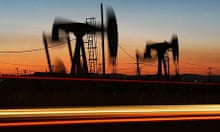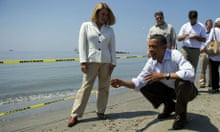In a small, wood-panelled courtroom in the back streets of Belle Chase on the banks of the Mississippi, a trial of sorts is taking place. Chief witness for the prosecution is a large rotund man with a breeze-reddened face who is addressing the legal benches and the packed public area with growing passion.
"Where is the plan?" he says, speaking into a microphone. "We have been waiting and waiting for a plan, and still there isn't one. There is no plan."
In the dock the absentee defendants are BP, the US coastguard and the federal government, who all stand accused in the court of local public opinion of failing to protect Louisiana's rich coastline from the oil disaster unfolding in the Gulf of Mexico.
Billy Nungesser, the elected parish chief for this stretch of the Mississippi, has come to address the full council, assembled for convenience's sake in this unused courtroom.
"We are going to throw everything and the kitchen sink at this, and we don't care if we don't have permission. Come Saturday, we are going to go out there and begin the clean-up, with or without BP."
The public bursts into applause. This being a council meeting and not a proper trial there is no judge to call the room to order. If it had been a criminal setting, and not a civil assembly of council officials, you might call it vigilantism.
It began last Sunday in a spontaneous expression of frustration at the apparent lack of action to protect Louisiana's wetlands, one of America's largest and richest ecosystems, from the menacing swirl of oil gathering off the coast from the stricken Deep Horizon well.
As the first big flows of oil began to reach land last weekend, local people were astonished to find 30 private shrimp boats sitting idle at Grand Isle, a pristine stretch of beach that was now directly threatened. BP had commissioned the boats for use in fighting the slick, but had left them doing nothing.
Nungesser, backed by the governor of the state of Louisiana, Bobby Jindal, went it alone. They "commandeered" the boats and mobilised fishermen, sending them out to lay a boom in front of Grand Isle to hold back the oil.
Such was the success of that action – both in terms of ameliorating the oil impact and in boosting the morale of those involved – that Nungesser then wanted to roll it out across the marshlands. "We can't wait anymore for BP to give us permission, we're going ahead anyway," he told the courtroom.
Outlining his alternative plan, he said that on Saturday two teams of about 50 people would be sent out to barrier islands off the coast to begin dredging up small berms (barriers) to keep the oil from getting into the marshes.
Where oil had already encroached into the sensitive grasses of the wetlands, special equipment would be used to drive it out then collect it.
A helicopter supplied by the sheriff's office would act as their eyes overhead and they would be advised by Philippe Cousteau, grandson of the underwater explorer Jacques. It was into this cauldron of brewing anger that Barack Obama jumped on yesterday, touring Louisiana for the second time since the crisis had begun on 20 April with the explosion of the Deep Horizon rig.
With every day that passes, comparisons between the oil spill and George Bush's disastrous handling of the Katrina hurricane in 2005 become more prevalent, and with them the political perils for the Obama administration.
As it happens, one of the US president's supporters over his handling of the crisis is Nungesser. The two met the last time Obama visited the region, and Nungesser was impressed by his willingness to listen to ideas about what to do.
When a coastguard official expressed doubt about the efficacy of Nungesser's suggestions, Obama turned to that official and said: "You got a better plan?"
According to the US coastguard, more than 100 miles of shoreline in Louisiana has now been affected by the oil, only a quarter of which will easily be cleaned. More than a million feet of protective booms have been laid around the most endangered islands and bayous, an emergency response that the coastguard claims has been "historic", "epic" and largely successful.
But the contrast between the rhetoric and what they see has baffled residents. If the response has been so successful, why was oil coming ashore this week with no attempt to stop it? Why have booms been laid in stretches that appear to be ad-hoc and patchy? Why, when you approach the authorities for permission to protect a marshland, is there so much red tape and no clear accountability between BP, the coast guard and the federal government?
Above all, they ask, why, with the disaster declared bigger than Exxon Valdez, the worst in US history, does there seem to be such a lack of urgency?
"It's sad to see the oil just sitting there," said Darren Crowe, a Louisiana state senator, after Nungesser finished speaking. "It's like your house is burning down when you have a fire engine sitting there right over the road."
We take a boat out to look at some of the affected areas, speeding along bayous through a bed of grasses that extends to the horizon. As the waterways open into the bay we come to Cat island where thousands of pelicans are nesting.
The island has been encircled with orange booms that are meant to contain the oil, but the equipment seems in need of maintenance as in parts it has been deposited on shore. The island was awash with oil two days ago, collected between the rings of the boom.
The neighbouring island, Queen Bess, has oil in patches on the grasses, rendering them dark brown and greasy,. A group of pelicans and their young are perched three metres away.
For now the oil has gone again, swept back out to sea by changing winds. But everybody expects that, in days, weeks, months, maybe even years, it will be back again, and they want to know what is going to be done to stop it next time.


